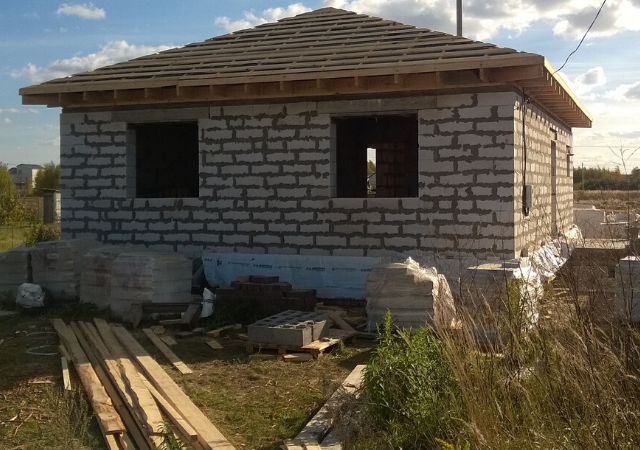A carpenter told me that when Hurricane Irma hit Antigua and Barbuda in 2017, many of the roofs that were not ripped off, were secured with hurricane straps. This should be more than enough to convince you that a hurricane strap installation on your home or shed should be done as soon as possible. Although there is no guarantee that your roof will survive a Category 5 hurricane, the hurricane strap is an economical addition to your home’s arsenal that you cannot afford to ignore.
Depending on where you live, these straps may already be part of the building code. Newer construction would be required to install straps to pass inspections and satisfy the requirements of the code. However, roofs on older homes may not have been required to install hurricane straps. But, they can be retrofitted with hurricane straps to strengthen and protect the home.
What is a Hurricane Strap?
A hurricane strap is a connector that is used to strengthen wood framed roofs and homes. The most popular hurricane straps are made of galvanised steel or stainless steel and they are designed to protect structures from the ravages of adverse weather events such as tropical storms and winter storms. Properties that lie in any tropical weather area, should be equipped with them. Other names for hurricane straps are hurricane ties, hurricane brackets, hurricane anchors and hurricane clips and hurricane strips.
Types of Hurricane Straps
There are several types of hurricane brackets, each of which have various purposes for the protection of the home. In a thorough technical manual on Hurricane Straps, BRC West Indies, a manufacturer of hurricane straps, outlines the wide range of straps available in their product catalog. These straps have been tested “recognising the characteristics of repeated, dynamic and fluctuating loads” that occur in tropical storm events.
The different types of hurricane ties available at BRC are:
- Timber connectors – Connect beams, purlins, wall plates, floor plates, rafters and studs to the structure
- Rafter connectors – Connect rafters to ridge boards
- Rafter/ purlin clips – Connect rafters/ purlins/ battens to supporting rafters
- Multipurpose straps – Connect roofs, walls and foundations of timber buildings
- Mending plates – Support lower load members
- Truss anchors – Connect concrete beams to rafters
- Moment connectors – Connect butt junctions
- Twist ties – Connect wood members
- Purlin braces – Fasten purlins/ battens to rafters
Descriptions for each of these straps include a permissible design load and suggestions on the types of nails which are required can be found on the BRC website.
[showad block=8]How to Install Hurricane Straps
A hurricane strap installation requires a clear understanding of which straps should be used on which section of the roof. Straps should be installed in specific structural members and must be spaced accordingly. As mentioned previously, there are various types of hurricane straps, each with their own purpose and design load specification.
If you are seriously considering installing hurricane clips on your home, my advice would be to consult with a reputable civil engineer and carpenter. If you are adamant that you can do it yourself, there are manuals that can offer assistance. For reference purposes you can also refer to the following videos which explain how to install hurricane anchors on existing roofs, new roofs and on rafters and trusses.
How to Install Hurricane Straps on an Existing Roof
How to Install Hurricane Straps on a New Roof
How to Install Hurricane Straps on Rafters/ Trusses
How to Install Hurricane Straps on Beams
How to Install Hurricane Straps on Decks
How to Install Hurricane Straps on Foundations
Hurricane Strap Installation (Frequently Asked Questions)
There are a few questions that pop up time and time again with no solid response. Here are some of these questions and answers.
Q: Are hurricane straps required in my area?
Yes. Especially if you live in an area that is impacted by tropical storms and tropical weather systems, you should install hurricane straps. Your home should have hurricane straps that have been installed correctly.
Q: Are hurricane straps required in Florida?
Yes. After 1992’s Hurricane Andrew, Florida’s building code was updated to require that all new construction (including both timber and concrete), be equipped with hurricane ties. Unfortunately, homes built before this period may not have them installed. However, it is possible to retrofit homes with straps post construction.
Q: Are hurricane straps required in the Caribbean?
Yes, because the Caribbean is prone to tropical weather. However, not all building codes or building guidelines in the Caribbean are enforced as they should. Additionally, not all building professionals are knowledgeable about hurricane straps, and they may not use them or install them correctly.
Q: Are there hurricane straps for older homes?
Yes. There are hurricane straps that can be installed on older homes. However, because it may be difficult for a homeowner to access the roof, a professional may be required to retrofit the home.
Q: My home has hurricane straps that were installed by previous owners. Does this mean that my roof is safe?
Unfortunately no. There are several instances where hurricane straps have been installed incorrectly. As a result, you will have to request an inspection by a reputable company to confirm that your straps meet the building code and technical specifications.
Q: Where can I find information about starting my hurricane strap installation project?
You can safely refer to hurricane strap manuals which are usually prepared by manufacturers such as BRC and Strong Tie. In addition, you can also review instructions posted on Hunker, Do It Yourself and WikiHow.




